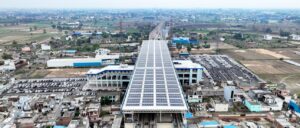Representing a major stride toward sustainability, NCRTC has commissioned a 717 kWp rooftop solar power plant at Meerut South Namo Bharat Station. This installation marks a significant milestone in the Delhi–Meerut RRTS corridor’s journey to carbon neutrality, generating over 8 lakh units of green energy annually and minimising 750 tonnes of CO₂ emissions.
Introduction:
To further its commitment to sustainable infrastructure and clean energy, the National Capital Region Transport Corporation (NCRTC) has successfully installed a 717-kilowatt peak (kWp) rooftop solar power plant at Meerut South Namo Bharat Station. This development is part of NCRTC’s ongoing efforts to integrate renewable energy solutions across the Delhi–Ghaziabad–Meerut RRTS corridor under the Namo Bharat brand.
This newly commissioned plant is poised to generate approximately 8.15 lakh units of solar energy annually, which will cut down nearly 750 tonnes of carbon emissions each year. A total of 1,304 high-efficiency solar panels, each with a capacity of 550-watt peak, have been deployed on the station’s rooftop.

Part of a Larger Renewable Push Across the Namo Bharat Corridor:
This installation is not an isolated initiative. It adds to a growing network of solar-powered facilities already operational at stations like Sahibabad, Ghaziabad, Guldhar, and Duhai, as well as at the Duhai Depot and receiving sub-stations in Ghaziabad and Muradnagar.
With the commissioning of the Meerut South plant, the total in-house solar power generation capacity across the corridor has now reached approximately 4.7 MWp. This capacity is estimated to minimise over 4,900 tonnes of carbon emissions annually, a significant move towards NCRTC’s target of 11 MW solar power generation from the entire 82 km corridor.
Highlight – Ghaziabad Station Leads in Capacity:
Among all installations so far, Ghaziabad Station boasts the highest rooftop solar capacity, generating up to 1 MW (965 kWp). Other stations are currently undergoing similar upgrades, aiming to match or exceed this benchmark. These amenities are designed to meet the auxiliary power needs of each station, making them self-sufficient and carbon neutral in operations.
Supporting India’s National Solar Mission:
This clean energy initiative is in direct alignment with the National Solar Mission, which envisions large-scale solar integration to reduce dependency on fossil fuels. NCRTC’s solar policy focuses on increasing the share of renewables in its operations, reinforcing India’s national aim for climate resilience and sustainability.
Recognition of Sustainability – IGBC Net Zero Energy Ratings:
NCRTC’s environmentally responsible approach is gaining industry recognition. Notably, the Sahibabad and Guldhar stations have been awarded the prestigious IGBC Net-Zero Energy (Operations) rating, making them the first stations in the country to receive such an honor.
The IGBC certification signifies that these stations generate as much energy as they consume through sustainable practices. This includes solar power, rainwater harvesting, LED lighting, green landscaping, and natural lighting systems, further reducing their environmental footprint.
Promoting Green Rail Systems and Energy Efficiency:
NCRTC’s sustainability measures extend beyond solar infrastructure. The Namo Bharat trains themselves feature regenerative braking systems, a cutting-edge technology that transforms kinetic energy into electrical energy during braking. This not only contributes to energy savings but also lower wear on key train components like wheels and brake pads, lowering long-term maintenance costs.
These features showcase NCRTC’s vision of building intelligent, energy-efficient transport systems that are both commuter-friendly and environmentally sound.
Current Operational Stretch and Way Forward:
The Delhi-Ghaziabad-Meerut corridor, spanning 82 km, is being developed as India’s first Regional Rapid Transit System (RRTS). As of now, a 55 km stretch from New Ashok Nagar to Meerut South, comprising 11 stations, is operational. Trial runs are actively underway on the remaining sections of the corridor.
With advancing steps like these, NCRTC aims to catalyze a green transformation in India’s transit infrastructure, encouraging more cities and agencies to adopt sustainable development models in public transportation.
Conclusion:
The deployment of the 717 kWp solar plant at Meerut South marks yet another milestone in NCRTC’s clean energy journey. By harnessing solar power to run its stations and systems, NCRTC not only supports India’s green goals but sets a record for sustainable mass transit development in the country.
Source: NCRTC – Press Release | Images Credit: NCRTC
Join us to showcase Innovation in Rail & Metro sector of India- Book your Delegate Pass: https://railanalysis.in/info/delegate.html
![]() Timely insights, straight to your WhatsApp—stay updated with ease!
Timely insights, straight to your WhatsApp—stay updated with ease!
![]() Stay connected to the rail industry—timely news, straight to Telegram!
Stay connected to the rail industry—timely news, straight to Telegram!


